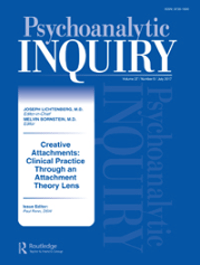– Paul Renn – Clinical Practice Through an Attachment Theory Lens
– Betsy Cohen – A Flexible Frame: Holding the Patient in Mind
– Beatrice Beebe– Daniel Stern: Microanalysis and the Empirical Infant Research Foundations
– Beatrice Beebe, Frank Lachmann – Maternal Self-Critical and Dependent Personality Styles and Mother-Infant Communication
– Ruth Lijtmaer – Who are the Torturers and Suicide Bombers?
Creative Attachments:
Clinical Practice Through an Attachment Theory Lens
Journal Announcement by Paul Renn (UK)
 I recently edited an issue of Psychoanalytic Inquiry (Volume 37, Number 5, 2017) on the topic of the creative use of attachment theory in clinical practice. My decision to focus on clinical practice was influenced by the fact that my work with adults is centrally informed by attachment theory and research. This, in turn, reflects the fact that attachment ideas and empirical findings inform many new ways of thinking about clinical issues and the therapeutic process. Contributors to this issue include Peter Fonagy, Chloe Campbell, Morris Eagle, Stephen Seligman, Jeremy Holmes, Giovanni Liotti, Paul Wachtel, and Christopher Clulow. These authors, individually and collectively, suggest that embracing an attachment dimension can greatly enhance our understanding of our patients’ subjective experience, and illustrate how this approach can productively inform our clinical work. The articles also support the view that attachment theory should not be thought of as a theoretical model separate and distinct from psychoanalysis but, rather, as a psychoanalytic perspective.
I recently edited an issue of Psychoanalytic Inquiry (Volume 37, Number 5, 2017) on the topic of the creative use of attachment theory in clinical practice. My decision to focus on clinical practice was influenced by the fact that my work with adults is centrally informed by attachment theory and research. This, in turn, reflects the fact that attachment ideas and empirical findings inform many new ways of thinking about clinical issues and the therapeutic process. Contributors to this issue include Peter Fonagy, Chloe Campbell, Morris Eagle, Stephen Seligman, Jeremy Holmes, Giovanni Liotti, Paul Wachtel, and Christopher Clulow. These authors, individually and collectively, suggest that embracing an attachment dimension can greatly enhance our understanding of our patients’ subjective experience, and illustrate how this approach can productively inform our clinical work. The articles also support the view that attachment theory should not be thought of as a theoretical model separate and distinct from psychoanalysis but, rather, as a psychoanalytic perspective.
Link to journal issue: http://www.tandfonline.com/toc/hpsi20/37/5?nav=tocList
 Paul Renn, DSW
Paul Renn, DSW
Psychoanalytic Psychotherapist
Email: paul_renn2003@yahoo.co.uk
 Back to Top
Back to Top
A Flexible Frame: Holding the Patient in Mind
Article Announcement by Betsy Cohen (USA)
Jung Journal: Culture & Psyche, Volume 11, Number 3, p. 68-81, 2017.
In this article the author questions the classical psychoanalytic frame as the basis for the analytic container. The history of the concept of the frame and its purpose are reviewed. Five clinical vignettes where the therapy takes place outside the boundaries of the traditional frame (through email, text, or phone) are offered. In each vignette, the patient felt held in mind and valued in a way not accessible during the session, even after many years of treatment. The author questions whether therapy that takes place only within the analytic frame can help the patient who has never felt held in mind by a parental figure. The author acknowledges that the current culture of psychotherapy is changing. The frame, in many ways, IS the relationship and can be held internally. She promotes a hermeneutics of trust over one of suspicion and encourages the modern therapist’s use of ancient cardinal virtues over a rule-bound psychotherapy.
Link: http://www.tandfonline.com/eprint/uQkxpPwmNuGgKwxG22GX/full
 Betsy Cohen, PhD
Betsy Cohen, PhD
Email: betscohen@aol.com
Daniel Stern: Microanalysis and the
Empirical Infant Research Foundations
Article Announcement by Beatrice Beebe (USA)
Psychoanalytic Inquiry, Volume 37, Number 4, p. 228-241, 2017.
Daniel Stern changed the face of psychoanalysis, as well as that of infant research. He was a brilliant, innovative, and playful thinker. Psychoanalysis particularly values his contributions on the relevance of infant research to adult clinical practice and theory, for which he is best known. But this work has its foundation in his early empirical infant research, which is less well known. I believe that a better appreciation of the original empirical basis of his work using microanalysis will deepen our appreciation of his later thinking.
In this article I return to the beginning of his work, using frame-by-frame microanalysis of film and, particularly, his first paper published in 1971. I sketch out some of the important findings and ideas emerging from this paper that continued to influence his thinking throughout his career. This research was conducted in the 1970s, the period in which I worked with him directly.
Link: http://www.tandfonline.com/doi/full/10.1080/07351690.2017.1299498
 Beatrice Beebe, PhD
Beatrice Beebe, PhD
New York State Psychiatric Institute
Email: Beatrice.beebe@nyspi.columbia.edu
Maternal Self-Critical and Dependent Personality Styles and
Mother-Infant Communication
Article Announcement by Beatrice Beebe (USA) and Frank Lachmann (USA)
Journal of the American Psychoanalytic Association, Volume 65, Number 3, p. 491-508, 2017.
This study investigated mother-infant communication in relation to Blatt’s measures of adult personality organization, namely, interpersonal relatedness and self-definition, defining the higher ends of these two measures as dependency and self-criticism, respectively. A nonclinical sample of 126 mother-infant dyads provided the data. An evaluation of maternal self-criticism and dependency was made six weeks postpartum; four months postpartum, mother-infant self- and interactive contingencies during face-to-face play were studied and analyzed in conjunction with the earlier evaluation. Self- and interactive contingencies were defined by the predictability within, and between, the behaviors of each partner. This approach assesses the process of relating from moment to moment within a dyad. Self-contingency measures the degree of stability/variability of one person’s ongoing rhythms of behavior; interactive contingency measures the likelihood that one person’s behavior is influenced by the behavior of the partner. Infant and mother facial affect, gaze, and touch, and infant vocal affect, were coded second by second from split-screen videotape.
Maternal self-criticism and dependency had strikingly different effects on mother-infant communication. Self-critical mothers showed lowered attention and emotion coordination, staying more “separate” from infants in these realms, compromising infant interactive efficacy. This finding is consistent with Blatt and colleagues’ descriptions of self-critical individuals as preoccupied with self-definition, compromising relatedness. Dependent mothers and their infants showed reciprocal emotional vigilance, consistent with Blatt and colleagues’ description of dependent individuals as “empty” and “needy” of emotional supplies from their partner. The study documents that the influence of the mother’s personality organization operates through both infant and maternal contributions, a co-created process rather than a direct unilateral transmission from mother to infant.
Link: http://journals.sagepub.com/doi/10.1177/0003065117709004
 Beatrice Beebe, PhD
Beatrice Beebe, PhD
New York State Psychiatric Institute
Email: Beatrice.beebe@nyspi.columbia.edu
 Frank M. Lachmann, PhD
Frank M. Lachmann, PhD
Suite 1-O, 140 Riverside Dr
New York, NY 10024 USA
Email: framlach@aol.com
Back to Top
Who are the Torturers and Suicide Bombers?
Article Announcement by Ruth Lijtmaer (USA)
Journal of the International Federation for Psychoanalytic Societies (2017): http://www.tandfonline.com/loi/spsy20.
In this paper Ruth Lijtmaer discussed the social, economic, and political influences that lead to dehumanizing and blaming the “other,” dehumanizing the chosen enemy and justifying the extermination of dangerous “elements” as part of a battle between good and evil. In the case of suicide bombers and terrorists, sacrifice and devotion to the ideology that promises martyrdom and support for sacred ideals are requirements. The torturer follows orders to be accepted by the dominant dictatorship, perhaps rising in rank or acquiring monetary rewards.
 Ruth M. Lijtmaer, PhD
Ruth M. Lijtmaer, PhD
88 West Ridgewood Ave.
Ridgewood, NJ 07450 USA
email: rlijt123@gmail.com

